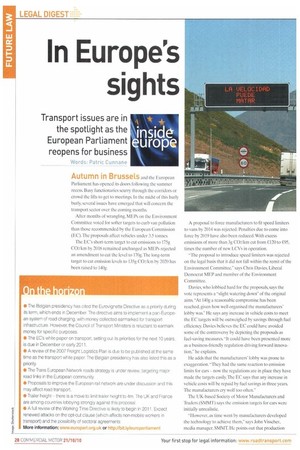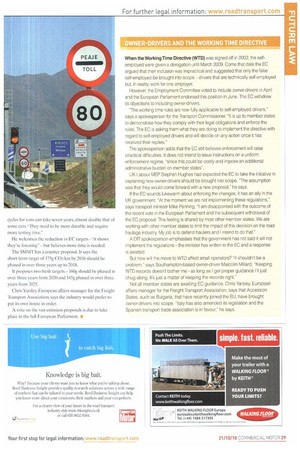In Europe's sights
Page 28

Page 29

If you've noticed an error in this article please click here to report it so we can fix it.
Transport issues are in the spotlight as the European Parliament reopens for business
Words: Patric Cunnane
Autumn in Brussels and the European Parliament has opened its doors following the summer recess. Busy functionaries scurry through the corridors or crowd the lifts to get to meetings. In the midst of this burly burly, several issues have emerged that will concern the transport sector over the coming months.
After months of wrangling, MEPs on the Environment Committee voted for softer targets to curb van pollution than those recommended by the European Commission (EC). The proposals affect vehicles under 3.5 tonnes.
The EC's short-term target to cut emissions to 175g CO2/kin by 2016 remained unchanged as MEPs rejected an amendment to cut the level to 170g.The long-term target to cut emission levels to 135g CO2/km by 2020 has been raised to 140g.
A proposal to force manufacturers to fit speed limiters to vans by 2014 was rejected. Penalties due to come into force by 2019 have also been reduced. With excess emissions of more than 3g CO2/kin cut from €120 to €95, times the number of new LCVs in operation.
"The proposal to introduce speed limiters was rejected on the legal basis that it did not fall within the remit of the Environment Committee," says Chris Davies, Liberal Democrat MEP and member of the Environment Committee.
Davies, who lobbied hard for the proposals, says the vote represents a -slight watering down" of the original aims "At 140g a reasonable compromise has been reached, given how well organised the manufacturers' lobby was.He says any increase in vehicle costs to meet the EC targets will be outweighed by savings through fuel efficiency. Davies believes the EC could have avoided some of the controversy by depicting the proposals as fuel-saving measures. "it could have been presented more as a business-friendly regulation driving forward innovation," he explains.
He adds that the manufacturers' lobby was prone to exaggeration. "They had the same reaction to emission limits for cars now the regulations are in place they have made the targets easily. The EC says that any increase in vehicle costs will be repaid by fuel savings in three years. The manufacturers cry wolf too often."
The UK-based Society of Motor Manufacturers and Traders (SMMT) says the emission targets for cars were initially unrealistic.
"However, as time went by manufacturers developed the technology to achieve them,says John Visscher, media manager, SMMT. He points out that production
cycles for vans can take seven years, almost double that of some cars, "They need to he more durable and require more testing time."
He welcomes the reduction in EC targets -it shows they're listening"— hut believes more time is needed.
The SRIVIT has a counter proposal. It says the short-term target of 175g, CO2/km by 2016 should be phased in over three years up to 2018.
It proposes two fresh targets — 160g should be phased in over three years from 2020 and 145g phased in over three years from 2025.
Chris Yarsley, European affairs manager for the Freight Transport Association, says the industry would prefer to put its own house in order.
A vote on the van emission proposals is due to take place in the full European Parliament, •




























































































































